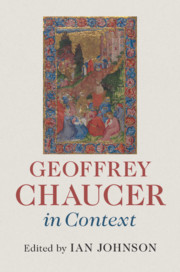Book contents
- Geoffrey Chaucer in Context
- Geoffrey Chaucer in Context
- Copyright page
- Contents
- Illustrations
- Contributors
- Abbreviations
- Introduction
- Part I Chaucer as Context
- Part II Books, Discourse and Traditions
- Part III Humans, the World and Beyond
- Part IV Culture, Learning and Disciplines
- Chapter 26 Childhood and Education
- Chapter 27 Philosophy
- Chapter 28 The Medieval Universe
- Chapter 29 Medicine and the Mortal Body
- Chapter 30 The Law
- Chapter 31 Art
- Chapter 32 Architecture
- Chapter 33 Heraldry, Heralds and Chaucer
- Part V Political and Social Contexts
- Part VI Chaucer Traditions
- Further Reading
- Index
Chapter 32 - Architecture
from Part IV - Culture, Learning and Disciplines
Published online by Cambridge University Press: 24 June 2019
- Geoffrey Chaucer in Context
- Geoffrey Chaucer in Context
- Copyright page
- Contents
- Illustrations
- Contributors
- Abbreviations
- Introduction
- Part I Chaucer as Context
- Part II Books, Discourse and Traditions
- Part III Humans, the World and Beyond
- Part IV Culture, Learning and Disciplines
- Chapter 26 Childhood and Education
- Chapter 27 Philosophy
- Chapter 28 The Medieval Universe
- Chapter 29 Medicine and the Mortal Body
- Chapter 30 The Law
- Chapter 31 Art
- Chapter 32 Architecture
- Chapter 33 Heraldry, Heralds and Chaucer
- Part V Political and Social Contexts
- Part VI Chaucer Traditions
- Further Reading
- Index
Summary
The fourteenth century was a period of extraordinary architectural creativity, with ideas first tentatively explored in the late thirteenth century being taken forward in brilliantly fresh ways. Those fresh ways were initially most prominently expressed in window tracery. On the one hand the ogee double-curve encouraged a taste for complex curvilinearity. On the other hand, a preference for grid-like rectilinearity ultimately inspired by French prototypes, but developed in strikingly new ways, was to set the pattern for the rest of the Middle Ages. Timber engineering was developed in several prodigiously inventive directions, with the central octagon of Ely Cathedral and the roof of Westminster Palace hall representing the highest achievements. The Royal Office of Works was an important forcing ground for new talent, as seen at St Stephen’s Chapel in Westminster; many named architects were recorded as working under the Office’s aegis before taking their creativity onto projects elsewhere.
Keywords
- Type
- Chapter
- Information
- Geoffrey Chaucer in Context , pp. 273 - 285Publisher: Cambridge University PressPrint publication year: 2019

